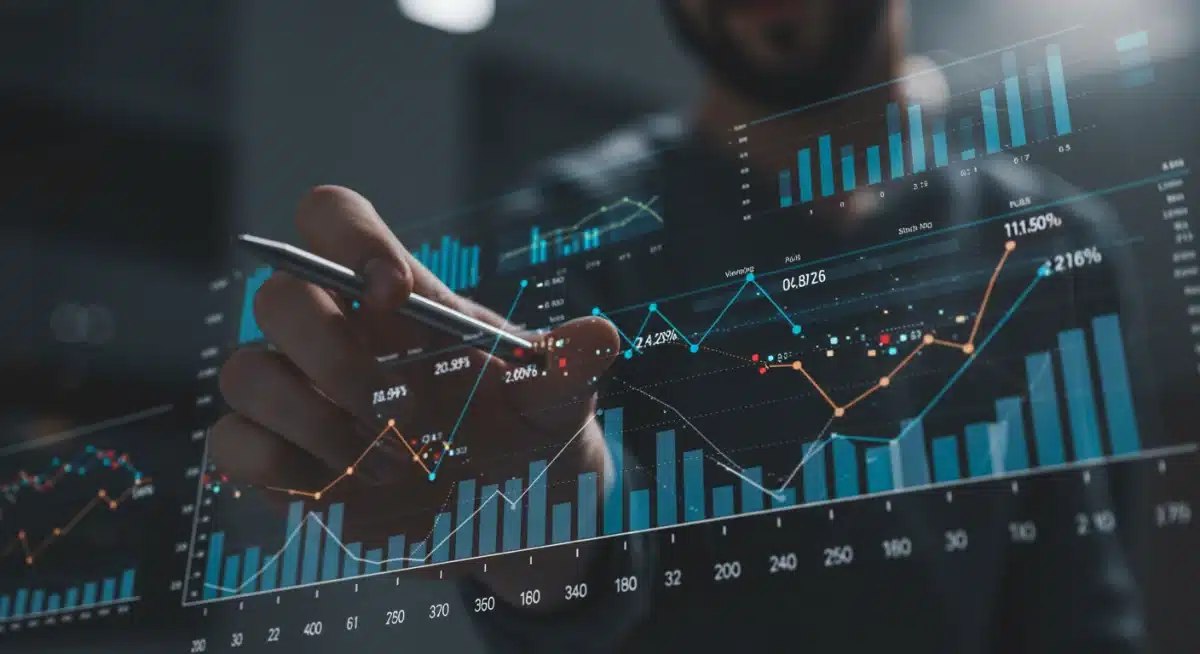2025 Consumer Spending Forecast: U.S. Retailers’ Outlook

The 2025 consumer spending forecast reveals a complex landscape for U.S. retailers, driven by evolving economic factors and shifts in consumer behavior, demanding adaptive strategies for sustained growth.
Understanding the 2025 Consumer Spending Forecast: What It Means for U.S. Retailers is crucial as new economic data emerges, painting a picture of both challenges and opportunities. Retailers are currently navigating a dynamic environment shaped by inflation, evolving consumer preferences, and technological advancements, all of which will significantly influence purchasing decisions next year.
Key Economic Drivers Shaping 2025 Spending
As of late 2024, several macroeconomic factors are converging to influence the 2025 consumer spending forecast. Inflation, while showing signs of cooling, remains a significant concern, directly impacting purchasing power. Interest rates, though stable, continue to affect borrowing costs for both consumers and businesses, shaping decisions on major purchases.
Employment figures, which have generally remained strong, are a critical barometer. A robust job market typically translates to higher disposable income, fueling consumer spending. However, any softening in employment could quickly dampen consumer confidence and reduce non-essential expenditures.
Inflationary Pressures and Their Impact
Persistent inflation has forced consumers to prioritize essential goods and services, often at the expense of discretionary spending. This trend is expected to continue into 2025, albeit potentially at a slower pace. Retailers must be acutely aware of how price sensitivity will dictate consumer choices.
- Budget-Conscious Choices: Consumers are actively seeking value, discounts, and promotions.
- Shift in Spending Categories: Increased allocation to groceries and utilities, less to apparel and entertainment.
- Private Label Growth: A rise in demand for store brands and generic alternatives.
Interest Rate Environment
The current interest rate landscape influences consumer borrowing for big-ticket items like cars and homes, indirectly affecting their available funds for retail purchases. Higher rates can lead to reduced credit card spending and a general tightening of household budgets.
Retailers should prepare for consumers who are more cautious about taking on new debt, potentially leading to a preference for smaller, more immediate purchases over large investments.
Evolving Consumer Behavior and Preferences
Beyond economic indicators, changes in consumer behavior are profoundly shaping the 2025 consumer spending forecast. The pandemic accelerated many trends, such as the shift to online shopping, and these habits are now firmly entrenched. Retailers must adapt to these evolving preferences to remain competitive.
Consumers are increasingly valuing convenience, personalized experiences, and ethical considerations when making purchasing decisions. This means that simply offering products is no longer enough; the entire shopping journey and brand values play a crucial role.
The Digital-First Imperative
Online retail continues its upward trajectory. Consumers expect seamless digital experiences, from browsing to checkout, across multiple devices. Retailers who neglect their e-commerce platforms risk losing significant market share.
- Mobile Optimization: Essential for capturing on-the-go shoppers.
- Personalized Recommendations: AI-driven suggestions enhance the shopping experience.
- Fast and Reliable Delivery: A key determinant for customer satisfaction and repeat business.
Sustainability and Ethical Consumption
A growing segment of consumers, particularly younger demographics, are making purchasing decisions based on a brand’s commitment to sustainability, ethical sourcing, and social responsibility. This is not merely a niche concern but a mainstream expectation.
Retailers that transparently communicate their efforts in these areas can build stronger brand loyalty and attract new customers. Conversely, those perceived as environmentally or socially irresponsible may face backlash and declining sales.
Impact on Specific Retail Sectors
The 2025 consumer spending forecast will not affect all retail sectors equally. Some categories are poised for growth, while others may face significant headwinds. Understanding these nuanced impacts is vital for U.S. retailers in planning their strategies.
Discretionary spending categories, such as luxury goods and certain entertainment options, are often the first to be impacted by economic uncertainties. Conversely, essential goods, discount retailers, and experiences that offer good value are likely to remain resilient or even thrive.
Grocery and Everyday Essentials
This sector is generally stable, as consumers will always need food and household items. However, inflation has pushed consumers towards more budget-friendly options, including private labels and discount grocery stores. Retailers here will focus on competitive pricing and loyalty programs.
Apparel and Fashion
The apparel sector faces ongoing challenges, with consumers seeking durability and value over fast fashion. The rise of resale markets and a focus on sustainable clothing choices are also influencing purchasing patterns. Brands that offer timeless pieces, ethical production, and a strong online presence are better positioned.
Home Goods and Furnishings
After a boom during the pandemic, this sector may see a moderation in spending, especially if housing markets cool. Consumers are likely to invest in quality, long-lasting items rather than frequent updates. Retailers should emphasize durability, design, and personalized home solutions.

Technological Innovations Driving Retail Forward
Technology continues to be a transformative force in retail, profoundly influencing the 2025 consumer spending forecast. From artificial intelligence to augmented reality, these innovations are not just enhancing efficiency but are fundamentally reshaping the customer experience and operational strategies for U.S. retailers.
The adoption of advanced technologies allows retailers to gain deeper insights into consumer behavior, personalize marketing efforts, and streamline supply chains. This translates into more targeted offerings and a more responsive retail environment, crucial for meeting evolving consumer demands.
Artificial Intelligence and Data Analytics
AI is becoming indispensable for understanding purchase patterns, predicting trends, and optimizing inventory management. Retailers leveraging AI can offer highly personalized product recommendations, improving conversion rates and customer satisfaction.
- Predictive Analytics: Forecasting demand to minimize stockouts and overstocking.
- Personalized Marketing: Tailoring promotions and content based on individual preferences.
- Customer Service Bots: Enhancing support and reducing response times.
Augmented Reality (AR) and Virtual Reality (VR)
AR and VR are transforming the shopping experience, especially for online consumers. AR allows customers to virtually try on clothes or visualize furniture in their homes, reducing returns and enhancing confidence in purchases. VR offers immersive virtual store experiences, blurring the lines between physical and digital retail.
These technologies provide a competitive edge by offering unique and engaging ways for consumers to interact with products before committing to a purchase, thereby improving the overall online shopping journey.
Strategic Adjustments for U.S. Retailers
Given the complexities of the 2025 consumer spending forecast, U.S. retailers must implement strategic adjustments to not only survive but thrive. A proactive approach, focusing on agility and consumer-centricity, will be key to navigating the anticipated economic and behavioral shifts.
Retailers need to reassess their business models, invest in new capabilities, and foster a culture of continuous adaptation. This includes revisiting pricing strategies, supply chain resilience, and talent development to meet the demands of a rapidly changing market.
Diversifying Sales Channels
A strong omnichannel presence is no longer optional. Retailers must seamlessly integrate their online and offline channels, providing a consistent brand experience regardless of how a customer chooses to shop. This includes click-and-collect options, in-store returns for online purchases, and unified loyalty programs.
Expanding into new marketplaces or exploring direct-to-consumer models can also help diversify revenue streams and reach broader audiences.
Supply Chain Resilience and Localization
Recent global disruptions have highlighted the fragility of extended supply chains. Retailers are increasingly looking towards localization and diversification of suppliers to mitigate risks and ensure product availability. This not only enhances reliability but can also appeal to consumers interested in supporting local economies.
- Nearshoring/Reshoring: Reducing reliance on distant manufacturing hubs.
- Inventory Optimization: Implementing advanced systems to balance stock levels efficiently.
- Ethical Sourcing: Ensuring transparency and responsible practices throughout the supply chain.
The Role of Data in Future Retail Success
In the context of the 2025 consumer spending forecast, data is unequivocally the new currency for U.S. retailers. The ability to collect, analyze, and act upon consumer data will differentiate successful businesses from those that struggle to keep pace. Data-driven insights enable personalized experiences, optimized operations, and smarter business decisions.
Retailers must invest in robust data analytics platforms and cultivate a data-savvy workforce. Understanding customer journeys, preferences, and pain points through data allows for highly targeted strategies that resonate with individual consumers, fostering loyalty and driving sales.
Understanding Customer Journeys
Mapping the customer journey across all touchpoints—from initial discovery to post-purchase support—provides invaluable insights. Data helps identify bottlenecks, optimize interactions, and create a more frictionless path to purchase. This holistic view ensures that every interaction adds value.
Personalization at Scale
Leveraging data to deliver personalized experiences is paramount. This goes beyond simple name recognition; it involves understanding individual preferences, past purchase history, and browsing behavior to offer relevant products, content, and promotions. Personalization fosters a sense of connection and makes customers feel valued.
Retailers can use AI to power recommendation engines, tailor email campaigns, and even customize in-store experiences based on customer profiles. This level of customization is a significant driver of customer retention and increased average order value.
Operational Efficiency through Data
Beyond customer-facing applications, data analytics can significantly enhance operational efficiency. From optimizing store layouts based on foot traffic patterns to predicting staffing needs, data provides the intelligence required to run a leaner, more effective retail operation.
Effective use of data in inventory management reduces waste and ensures popular items are always in stock, while less popular ones don’t tie up capital. This directly impacts profitability and the ability to offer competitive pricing, which is crucial in a challenging spending environment.
| Key Trend | Impact on U.S. Retailers |
|---|---|
| Persistent Inflation | Consumers prioritize value, increasing demand for discounts and private labels across categories. |
| Digital-First Shopping | Requires seamless e-commerce, mobile optimization, and efficient delivery for sustained customer engagement. |
| Sustainability Focus | Brands with transparent ethical and environmental practices gain significant consumer loyalty and preference. |
| Technological Integration | AI and AR/VR enhance personalization, operational efficiency, and immersive shopping experiences. |
Frequently Asked Questions About 2025 Consumer Spending
Inflation is expected to continue influencing consumer spending by driving demand for value-oriented products and discounts. Consumers will likely prioritize essential goods, leading to a more cautious approach to discretionary purchases and a heightened focus on budget management.
E-commerce will remain a dominant force, with consumers expecting seamless digital experiences across all devices. Retailers must invest in mobile optimization, personalized online interactions, and efficient delivery services to meet these evolving expectations and maintain competitiveness in the market.
Yes, sustainability and ethical consumption are increasingly vital. A growing number of consumers, especially younger demographics, are basing purchasing decisions on a brand’s environmental and social responsibility. Transparent communication of these efforts will be crucial for building trust and loyalty.
Retailers can leverage AI for predictive analytics and personalization, and AR/VR for immersive shopping experiences. These technologies help optimize inventory, tailor marketing efforts, and enhance customer engagement, allowing for more responsive and efficient operations in a dynamic spending environment.
Retailers should focus on diversifying sales channels through omnichannel integration, strengthening supply chain resilience, and prioritizing data-driven insights. Adapting pricing strategies, investing in new capabilities, and fostering agility will be essential for navigating economic shifts and maintaining growth.
Looking Ahead
The 2025 consumer spending forecast signals a period of continued evolution for U.S. retailers. The interplay of economic pressures, shifting consumer values, and rapid technological advancements means that agility and a deep understanding of customer needs will be paramount. Retailers who proactively embrace data-driven strategies, invest in seamless omnichannel experiences, and authentically commit to sustainability are best positioned to capture consumer attention and market share in the year ahead.





